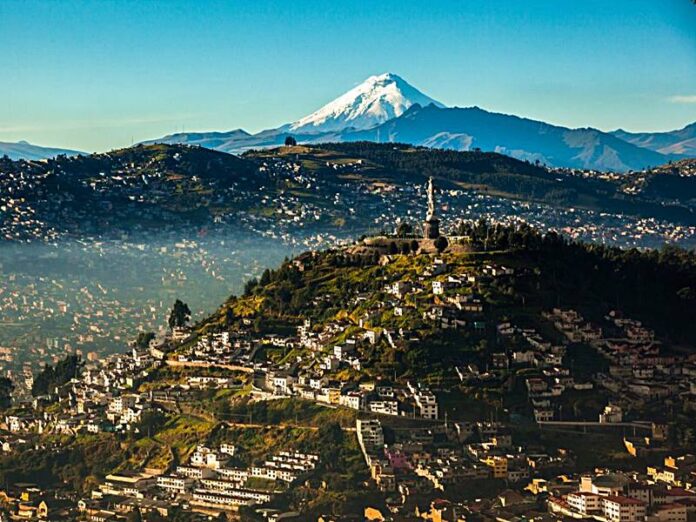Largest Cities in Ecuador, a beautiful country in South America, is home to numerous vibrant cities, each with its unique charm and climate. Let’s take a closer look at the top 10 largest cities in Ecuador by population, along with their respective provinces, regions, and day and night climate temperatures.
1. Guayaquil
- Province: Guayas
- Region: Coastal
- Climate: Day (28-30°C / 82-86°F), Night (22-24°C / 72-75°F)
Guayaquil, the largest city in Ecuador, is a bustling metropolis located on the country’s coastal region. With a population of approximately 2.7 million residents, it serves as a significant economic and cultural hub. The city’s history dates back to the 1530s when it was founded by the Spanish conquistadors, making it one of the oldest cities in South America. Over the centuries, Guayaquil has evolved into a vibrant and modern city, attracting visitors with its rich history and diverse attractions.
When it comes to cuisine, Guayaquil offers a delightful array of traditional Ecuadorian dishes. Ceviche, a mouthwatering seafood salad marinated in lime and served with plantain chips, is a local favorite. Additionally, encebollado, a hearty fish soup with onions and yuca, is a popular dish that reflects the coastal region’s culinary heritage.
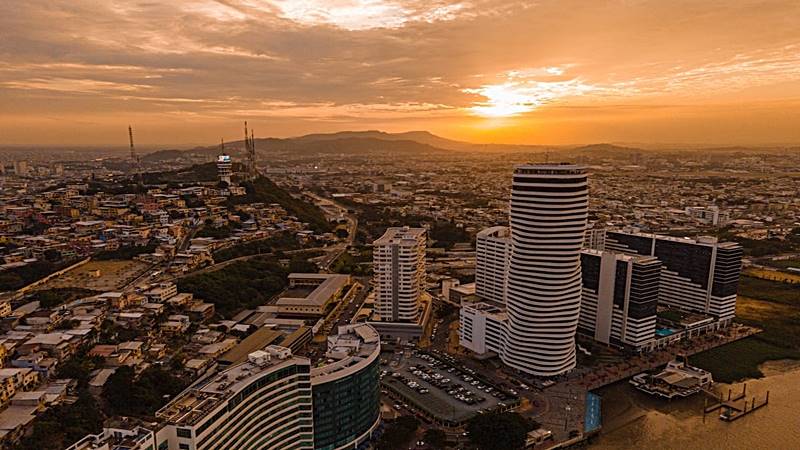
In Guayaquil, Ecuador, there are two major football teams:
- Barcelona Sporting Club: This is one of the most popular and successful football clubs in Ecuador. They play their home matches at the “Estadio Monumental Banco Pichincha,” which is the largest stadium in the country, with a capacity of around 58,000 spectators.
- Club Sport Emelec: Another prominent football club in Guayaquil, Emelec, also has a strong fan base. They play their home games at the “Estadio George Capwell,” named after one of the club’s founders, which has a seating capacity of approximately 24,000.
The rivalry between Barcelona and Emelec, known as “El Clásico del Astillero,” is one of the fiercest and most passionate football rivalries in Ecuador, attracting massive attention from fans and media alike.
For tourists, Guayaquil offers a diverse range of activities and attractions. The Malecón 2000, a scenic riverfront boardwalk, is a prime spot for leisurely walks, shopping, and dining. The historic Las Peñas neighborhood features picturesque colonial-style houses and art galleries. Moreover, the Parque Histórico, a living museum, allows visitors to explore the region’s cultural and ecological heritage. With its warm climate and lively ambiance, Guayaquil offers an exciting and memorable experience for travelers seeking to immerse themselves in Ecuador’s coastal charm.
2. Quito
- Province: Pichincha
- Region: Sierra
- Climate: Day (18-20°C / 64-68°F), Night (7-9°C / 45-48°F)
Quito, the capital city of Ecuador, is a vibrant urban center nestled in the Andes mountains. With a population of approximately 2.7 million people, it is not only the largest city in Ecuador but also one of the highest capital cities in the world. Quito’s history dates back to pre-Columbian times, and it was one of the first cities to be declared a UNESCO World Heritage Site in 1978, showcasing its rich cultural and historical significance.
Ecuadorian cuisine is celebrated in Quito, offering a delectable blend of traditional dishes. One iconic dish is “locro de papa,” a hearty potato soup seasoned with various spices and served with avocado and cheese. “Seco de chivo” is another popular choice, featuring tender goat meat stewed in a flavorful sauce and accompanied by rice and fried plantains.
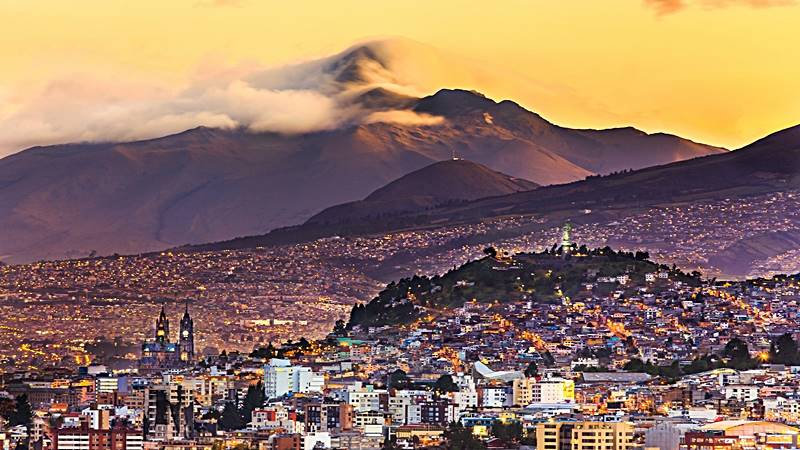
Quito boasts a passionate football culture, and the city is home to two prominent football teams:
- Liga Deportiva Universitaria (L.D.U. Quito): Commonly known as LDU Quito, this team has a strong fan base and plays their home matches at the “Estadio Rodrigo Paz Delgado,” also referred to as “Casa Blanca.” The stadium has a seating capacity of around 41,000.
- Club Deportivo El Nacional: Founded in 1964, this team is another significant football club in Quito. They play their home games at the “Estadio Olímpico Atahualpa,” with a capacity of approximately 35,000.
For tourists, Quito offers a plethora of activities and attractions. The historic center, or “Centro Histórico,” is a must-visit, showcasing stunning colonial architecture and iconic landmarks such as the “La Compañía de Jesús” church. Visitors can also take a thrilling ride on the TelefériQo, a cable car that offers breathtaking views of the city and surrounding mountains. Furthermore, the “Mitad del Mundo” monument marks the equator line and provides an intriguing experience straddling two hemispheres. With its rich history, diverse cuisine, and array of tourist offerings, Quito is a captivating destination for travelers seeking a mix of culture, adventure, and natural beauty.
3. Cuenca
- Province: Azuay
- Region: Sierra
- Climate: Day (19-21°C / 66-70°F), Night (10-12°C / 50-54°F)
Cuenca, located in the southern region of Ecuador, is a charming city renowned for its historical architecture and picturesque landscapes. With a population of approximately 700,000 inhabitants, it is the third-largest city in the country. Cuenca’s roots can be traced back to the Inca civilization, and it was officially founded by the Spanish conquistadors in 1557, making it one of the oldest cities in Ecuador. The city’s rich history is evident through its well-preserved colonial buildings and narrow cobblestone streets, which have earned it the status of a UNESCO World Heritage Site.
Ecuadorian gastronomy thrives in Cuenca, offering a delightful array of traditional dishes. One notable specialty is “cuy asado,” or roasted guinea pig, a unique and traditional delicacy often served during special occasions and festivals. “Mote pillo” is another popular local dish, featuring hominy corn seasoned with onions, eggs, and a choice of meat, typically served for breakfast.

In terms of football, Cuenca is home to one of Ecuador’s prominent football clubs:
- Club Deportivo Cuenca: Founded in 1971, this team plays its home matches at the “Estadio Alejandro Serrano Aguilar,” commonly known as “Estadio Cuencano.” The stadium has a seating capacity of around 22,000 and provides an exciting atmosphere during match days.
For tourists, Cuenca offers a plethora of attractions and activities. The city’s historic center is a captivating blend of colonial architecture and indigenous influences, boasting notable landmarks such as the “New Cathedral” and the “Old Cathedral.” The Tomebamba River runs through the city, providing scenic walking paths and parks where visitors can enjoy a leisurely stroll. Additionally, the nearby Cajas National Park offers breathtaking landscapes and hiking opportunities for nature enthusiasts. With its rich cultural heritage, natural beauty, and warm hospitality, Cuenca is a must-visit destination for travelers seeking an authentic Ecuadorian experience.
Largest Cities in Ecuador
4. Santo Domingo
- Province: Santo Domingo de los Tsáchilas
- Region: Coastal
- Climate: Day (28-30°C / 82-86°F), Night (22-24°C / 72-75°F)
Santo Domingo de los Tsáchilas, commonly known as Santo Domingo, is a bustling city in the Santo Domingo province of Ecuador. With a population of approximately 300,000 residents, it is a significant urban center in the region. While the city itself has a relatively modern history, the surrounding Santo Domingo province is rich in indigenous culture and has been inhabited for centuries by various indigenous groups.
Ecuadorian cuisine is celebrated in Santo Domingo, offering a delightful array of traditional dishes. One popular local delicacy is “fritada,” which consists of seasoned and fried pork served with hominy corn, plantains, and a side of llapingachos (potato patties). “Bolón de verde” is another must-try, made from green plantains mashed with cheese and fried to perfection.
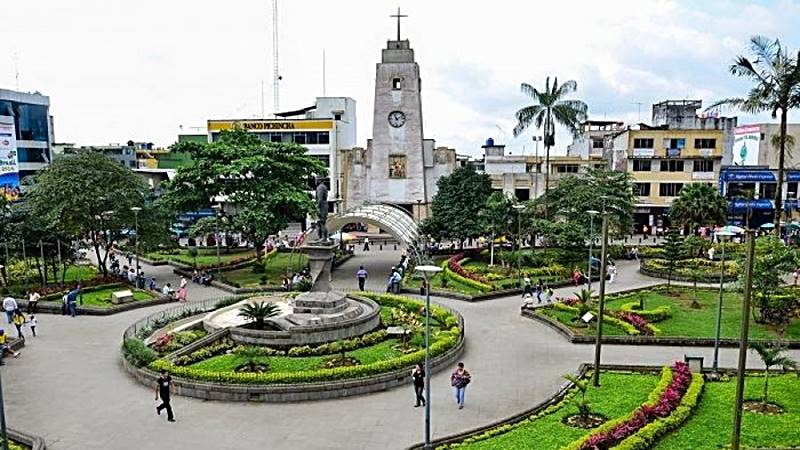
In terms of football, Santo Domingo has a football team that participates in the Ecuadorian Serie B league:
- Santo Domingo FC: The city takes pride in supporting their local football club, which plays its home matches at the “Estadio Olímpico Santo Domingo,” providing an exciting atmosphere for football enthusiasts.
For tourists, Santo Domingo offers various attractions and activities. The city’s vibrant markets, such as the “Mercado Amazonas” and “Mercado Municipal,” provide an authentic glimpse into daily life and local products. Nature enthusiasts can explore nearby nature reserves like “Parque Ecológico Piedra Blanca” and “Reserva Ecológica Los Illinizas,” which offer hiking and birdwatching opportunities. Additionally, visitors can immerse themselves in the local culture by attending traditional festivals like the “Fiesta de la Tsáchila” or “Feria Nacional de la Fruta y de las Flores.” With its cultural offerings, warm hospitality, and opportunities for outdoor exploration, Santo Domingo presents a unique and memorable experience for tourists in Ecuador.
5. Machala
- Province: El Oro
- Region: Coastal
- Climate: Day (27-29°C / 81-84°F), Night (21-23°C / 70-73°F)
Machala, situated in the El Oro province of Ecuador, is a bustling city known for its agricultural and commercial significance. With a population of approximately 240,000 residents, it is one of the major urban centers in southern Ecuador. The city’s history dates back to the 16th century when it was originally settled by Spanish colonizers. Over the centuries, Machala has evolved into an important economic hub, with a focus on banana production and export.
Ecuadorian cuisine thrives in Machala, offering a delectable variety of traditional dishes. “Encebollado de pescado,” a hearty fish soup with onions and yuca, is a popular choice among locals and visitors alike. “Arroz con menestra y carne asada” is another beloved meal, featuring rice, lentil stew, and grilled meat, reflecting the region’s agricultural influences.

Machala is home to a notable football club that competes in the Ecuadorian Serie A league:
- Fuerza Amarilla Sporting Club: The city’s football enthusiasts take pride in supporting their team, which plays its home matches at the “Estadio Nueve de Mayo.”
For tourists, Machala offers a blend of cultural experiences and outdoor activities. The “Malecón de Machala,” a picturesque riverfront promenade, provides a pleasant spot for leisurely walks and recreational activities. Visitors can also explore nearby banana plantations and learn about the banana cultivation process, which plays a significant role in the city’s economy. Moreover, the surrounding El Oro province offers beautiful beaches, such as “Playa de Jambelí,” where tourists can relax and enjoy the sun. With its unique blend of culture, gastronomy, and natural attractions, Machala offers a delightful Ecuadorian experience for travelers seeking to discover the country’s southern charm.
6. Manta
- Province: Manabí
- Region: Coastal
- Climate: Day (25-28°C / 77-82°F), Night (21-23°C / 70-73°F)
Manta, a coastal city in Ecuador, is a vibrant and rapidly growing urban center. With a population of approximately 250,000 residents, Manta is the second-largest city in the Manabí province. Its history dates back to pre-Columbian times when it was originally inhabited by indigenous cultures. Over the years, Manta has transformed into a bustling port city, attracting both commerce and tourism due to its strategic location on the Pacific coast.
Ecuadorian coastal cuisine thrives in Manta, offering a delectable array of seafood dishes. “Ceviche de camaron,” a flavorful shrimp ceviche marinated in lime and served with crunchy plantain chips, is a local favorite. “Pescado a la parrilla,” grilled fish seasoned with coastal spices, is another popular dish that reflects the city’s maritime heritage.

Manta is home to a prominent football club that competes in the Ecuadorian Serie A league:
- Manta Fútbol Club: The city’s football fans passionately support their team, which plays its home matches at the “Estadio Jocay.”
As one of the fastest-growing cities in Ecuador, Manta offers a range of activities and attractions for tourists. The city’s beautiful beaches, such as “Playa Murciélago” and “Playa El Murciélago,” attract visitors looking to soak up the sun and enjoy water sports. Manta’s rich cultural heritage can be explored at the “Museo del Banco Central,” where artifacts and exhibits showcase the region’s history. Additionally, the city’s lively malecón (boardwalk) offers an array of restaurants, bars, and shops, making it a popular spot for leisurely strolls and entertainment. With its growing urban landscape, thriving seafood cuisine, and beautiful coastal setting, Manta promises an enticing and memorable experience for tourists exploring Ecuador’s Pacific shores.
Largest Cities in Ecuador
7. Portoviejo
- Province: Manabí
- Region: Coastal
- Climate: Day (25-28°C / 77-82°F), Night (20-22°C / 68-72°F)
Portoviejo, the capital city of the Manabí province in Ecuador, is a bustling urban center with a population of approximately 250,000 residents. The city’s history can be traced back to the pre-Columbian era, as it was originally inhabited by indigenous cultures. It was later settled by Spanish colonizers in the 16th century and has since grown into a vibrant economic and cultural hub in the region.
Ecuadorian coastal cuisine thrives in Portoviejo, offering a delightful array of traditional dishes. “Corviche,” a mouthwatering mix of fish and green plantains, is a popular street food delicacy that captures the city’s culinary heritage. “Viche de pescado,” a flavorful fish stew cooked with yuca and spices, is another local favorite that reflects the coastal region’s gastronomic diversity.

Portoviejo is home to a notable football club that competes in the Ecuadorian Serie A league:
- Club Deportivo y Social Portoviejo: Known as “Delfín Sporting Club,” this team has a dedicated fan base, and they play their home matches at the “Estadio Reales Tamarindos.”
For tourists, Portoviejo offers a mix of cultural experiences and natural attractions. The city’s historic center features charming colonial architecture and iconic landmarks, such as the “Catedral de Portoviejo.” The nearby “Parque Eloy Alfaro,” a tranquil city park, offers a peaceful spot for relaxation and picnics. Additionally, visitors can explore the nearby beaches, such as “San Jacinto” and “San Clemente,” which offer beautiful stretches of coastline and opportunities for water sports. With its rich history, delectable cuisine, and range of activities, Portoviejo invites tourists to discover the coastal charm and cultural heritage of Ecuador’s Manabí province.
The distance between Portoviejo and Manta, two coastal cities in Ecuador, is approximately 45 kilometers (about 28 miles) when traveling by road. The journey by car typically takes around 45 minutes to 1 hour, depending on traffic and road conditions. Both cities are located in the Manabí province and are well-connected, making it convenient for travelers to explore the attractions and offerings of both destinations during their visit to the region.
8. Ambato
- Province: Tungurahua
- Region: Sierra
- Climate: Day (17-20°C / 63-68°F), Night (7-9°C / 45-48°F)
Ambato, nestled in the central Andes of Ecuador, is a lively city with a population of approximately 330,000 residents. The city’s history can be traced back to pre-Columbian times when it was inhabited by various indigenous groups. However, it was officially founded by the Spanish conquistadors in 1534. Ambato is known for its picturesque landscapes, pleasant climate, and vibrant festivals.
Ecuadorian cuisine thrives in Ambato, offering a delightful array of traditional dishes. “Fritada,” a popular dish made from seasoned and fried pork served with hominy corn, plantains, and llapingachos (potato patties), is a local specialty that tantalizes taste buds. “Llapingachos con cuy,” another beloved dish, features potato patties stuffed with cheese and served with roasted guinea pig, reflecting the region’s culinary diversity.
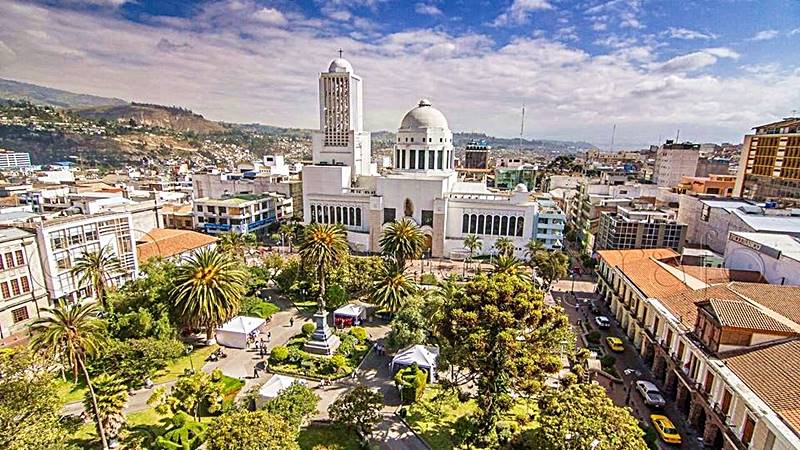
Ambato is home to a prominent football club that competes in the Ecuadorian Serie A league:
- Técnico Universitario: Known as “El Rodillo Rojo,” this team has a dedicated fan base and plays its home matches at the “Estadio Bellavista.”
For tourists, Ambato offers a variety of activities and attractions. The city’s picturesque setting surrounded by mountains and volcanoes creates a perfect backdrop for outdoor adventures such as hiking and nature walks. Visitors can explore the nearby “Parque Nacional Llanganates,” known for its lush forests, waterfalls, and diverse wildlife. Ambato is also famous for its vibrant festivals, such as “La Fiesta de las Flores y las Frutas,” a colorful celebration featuring parades, music, and dance. The city’s markets and craft shops offer opportunities to purchase traditional handicrafts and souvenirs. With its cultural heritage, stunning landscapes, and warm hospitality, Ambato welcomes tourists to experience the authentic charm of the Andean region of Ecuador.
Ambato, located in the Tungurahua province of Ecuador, is in close proximity to the popular tourist destination of Baños. Situated approximately 38 kilometers (about 24 miles) away, Baños is easily accessible from Ambato, making it a convenient and sought-after destination for tourists. Baños is renowned for its stunning natural beauty, including picturesque waterfalls, lush forests, and the towering Tungurahua volcano. The town is famous for its hot springs, offering a relaxing and rejuvenating experience for visitors. Moreover, Baños is a hub for adventure activities such as hiking, biking, zip-lining, and white-water rafting, providing endless opportunities for thrill-seekers. With its wealth of attractions and activities, Baños serves as a must-visit destination for tourists exploring the Tungurahua province, and Ambato serves as an excellent base to embark on such adventurous excursions.
9. Riobamba
- Province: Chimborazo
- Region: Sierra
- Climate: Day (18-20°C / 64-68°F), Night (7-9°C / 45-48°F)
Riobamba, situated in the Chimborazo province of Ecuador, is a picturesque city with a population of approximately 170,000 residents. The city’s history dates back to its foundation in 1534 by Spanish conquistadors. Riobamba, often called the “Sultan of the Andes,” is renowned for its colonial architecture, charming streets, and its breathtaking location at the foothills of the imposing Chimborazo volcano.
Ecuadorian cuisine thrives in Riobamba, offering a delightful array of traditional dishes. “Locro de papa,” a hearty potato soup seasoned with spices and served with avocado and cheese, is a local favorite that provides warmth in the Andean highlands. “Cuy asado,” roasted guinea pig, is another traditional delicacy often savored during special occasions and festivals, reflecting the region’s cultural heritage.

Riobamba has a football team that competes in the Ecuadorian Serie B league:
- Centro Deportivo Olmedo: Known as “Ciclón Andino,” this team has a dedicated fan base and plays its home matches at the “Estadio Olímpico de Riobamba.”
For tourists, Riobamba offers a range of attractions and activities. The city serves as a gateway to the breathtaking Chimborazo volcano, the highest peak in Ecuador and a favorite destination for mountaineers and adventure seekers. The “Nariz del Diablo” train ride, a historic railway journey through the Andes, offers stunning views of the surrounding landscapes. Additionally, visitors can explore nearby indigenous markets, such as “Guano” and “Pisahuí,” where traditional crafts and local products are sold. With its rich cultural heritage, natural beauty, and the majestic Chimborazo overlooking the city, Riobamba provides a captivating experience for tourists seeking to immerse themselves in the heart of the Andes.
10. Quevedo
- Province: Los Ríos
- Region: Coastal
- Climate: Day (27-30°C / 81-86°F), Night (21-23°C / 70-73°F)
Quevedo, located in the Los Ríos province of Ecuador, is a thriving city with a population of approximately 200,000 residents. The city’s history dates back to its official foundation in 1943, making it a relatively young urban center compared to other cities in Ecuador. Quevedo is known for its agricultural significance, particularly in the production of rice, bananas, and cocoa.
Ecuadorian cuisine thrives in Quevedo, offering a delicious array of traditional dishes. “Arroz con menestra y carne asada,” a hearty meal featuring rice, lentil stew, and grilled meat, is a local favorite enjoyed by residents and visitors alike. “Sancocho de pescado,” a flavorful fish soup with plantains and yuca, is another popular choice that reflects the city’s coastal influences.
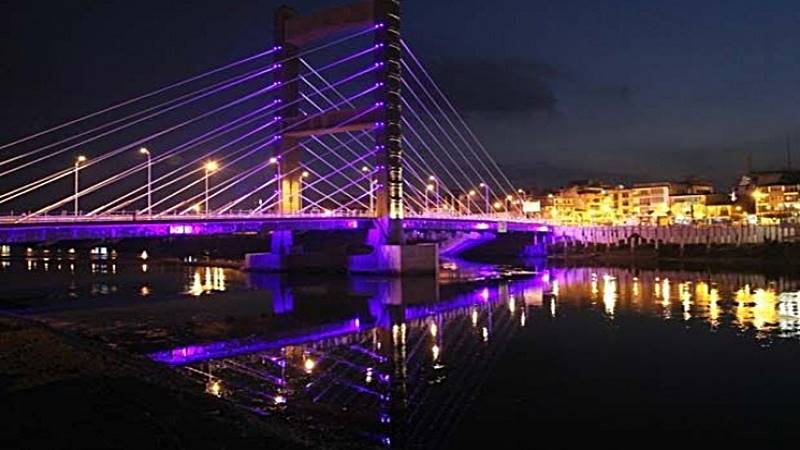
Quevedo is home to a notable football club that competes in the Ecuadorian Serie B league:
- Club Deportivo Quevedo: Known as “Los Tsáchilas,” this team has a passionate fan base and plays its home matches at the “Estadio 7 de Octubre.”
For tourists, Quevedo offers a variety of activities and attractions. The city’s central plaza, “Parque Santo Domingo,” is a popular spot for leisurely strolls and enjoying local street food. Visitors can explore nearby agricultural plantations and learn about the region’s agricultural practices, particularly in rice and banana production. Quevedo’s surrounding areas, such as the “Reserva Ecológica Los Monos,” provide opportunities for birdwatching and immersing in the region’s biodiversity. Additionally, the nearby towns of “Buena Fé” and “Valencia” offer traditional handicrafts and artisanal products, making for enjoyable shopping experiences. With its agricultural heritage, cultural offerings, and natural attractions, Quevedo welcomes tourists to discover the charm of the Los Ríos province in Ecuador.
Largest Cities in Ecuador
Ecuador’s diverse cities offer a mix of coastal and mountainous climates, with mild to warm temperatures during the day and cooler nights in the Sierra region. Whether you prefer the bustling energy of the coastal cities or the tranquility of the mountainous towns, Ecuador’s top 10 cities have something unique to offer to every visitor or resident.

